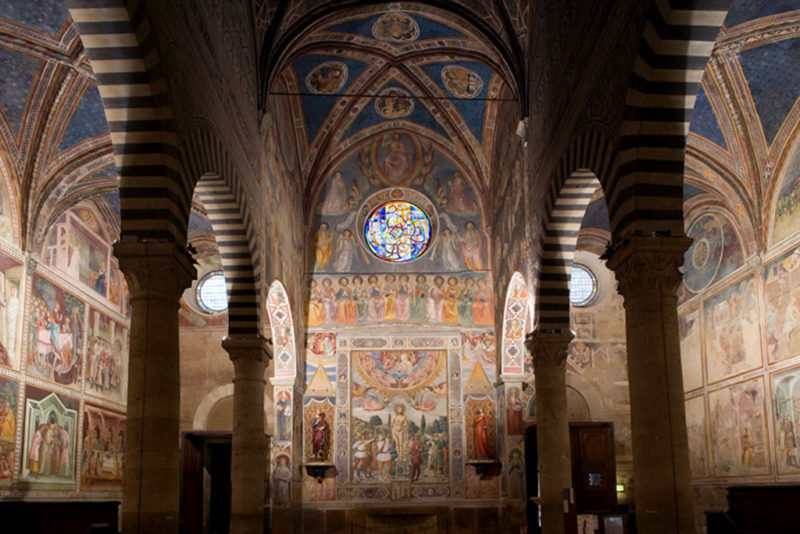Female Viewers
At the Collegiata church of San Gimignano, during a gathering of the full congregation, men and women entered the church through different doors on opposite sides of the nave. (1) In 1415, statutes were introduced in San Gimignano that prohibited women from entering through a certain door during the Liturgy of the Hours, or Divine Office. (2) Thus, women entered through the left-hand entrance, known as the Porta delle Donne, which put them in direct view of Taddeo di Bartolo’s Hell, the fresco most visible from that vantage point. (3) As they entered the sacred space, they were faced with imagery consisting of a monstrous laboring Satan and various women punished in an explicitly sexual manner. Formal stress is placed on these women, as Taddeo placed their punished bodies located right above the bottom arch of the fresco; their location on the lowest register situated the misogynistic infernal imaginings closest to the female viewers of the congregation. (4) Didactic misogynistic imagery and ecclesiastically enforced regulations dictated women’s experience in the sacred space of the Collegiata. This section will explore how these different regulations affected women’s viewing of the Hell fresco at the Collegiata of San Gimignano.
(1) Mann, 410
(2) Diane Norman, “The Case of the Beata Simona: Iconography, Hagiography, and Misogyny in Three Paintings by Taddeo di Bartolo,” Art History 18, no. 2 (1995): 174-75.
(3) Mann, 411.
(4) Norman, 173.
(5) Natalie Tomas, “Did Women Have a Space,” in Renaissance Florence: A Social History, ed. Roger Crum and John Paoletti. New York: Cambridge University Press, 2006. 319.
(6) Hayden B.J. Maginnis, “Lay Women and Altars in Trecento Siena,” Notes in the History of Art 28, no. 1 (2008): 6.
(7) Maginnis, 7.
(8) Margaret Aston, “Segregation in Church,” in Papers Read at the 1989 Summer Meeting and the 1990 Winter Meeting of the Ecclesiastical History Society (Oxford: for the Ecclesiastical History Society by Basil Blackwell, 1990): 244-45.
(9) St. Antoninus in his Opera a ben vivere, “and do this, go to the church and take good care of your sight…Walk with the eyes so low that you do not see beyond the ground upon which you must place your feet,” in Adrian W.B. Randolph, “Regarding Women in Sacred Space,” in Picturing Women in Renaissance and Baroque Italy, ed. Geraldine A. Johnson and Sara F. Matthews Grieco (Cambridge: Cambridge University Press, 1997): 39.
(10) Tomas, 319.
(11) Raber, 107-08.
(12) Aston, 320.
(13) Randolph, 28.
(14) Randolph, 28.
(15) William Durandus, The Symbolism of Churches and Church Ornaments: A Translation of the First Book of the “Rationale divinorum officiorum,” ed. J.M. Neale and B. Webb (London: 1906): 30-31. https://www.gutenberg.org/files/43319/43319-h/43319-h.htm. See also: Maginnis, 5; and Aston, 241-42.

